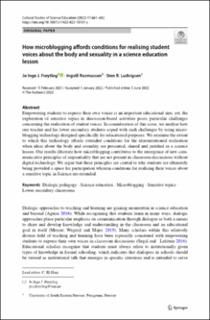| dc.contributor.author | Frøytlog, Jo Inge Johansen | |
| dc.contributor.author | Rasmussen, Ingvill | |
| dc.contributor.author | Ludvigsen, Sten Runar | |
| dc.date.accessioned | 2022-11-09T10:12:14Z | |
| dc.date.available | 2022-11-09T10:12:14Z | |
| dc.date.created | 2022-01-28T12:27:19Z | |
| dc.date.issued | 2022 | |
| dc.identifier.citation | Frøytlog, J. I. J., Rasmussen, I. & Ludvigsen, S. R. (2022). How microblogging affords conditions for realising student voices about the body and sexuality in a science education lesson. Cultural Studies of Science Education, 17(3), 661-682. | en_US |
| dc.identifier.issn | 1871-1502 | |
| dc.identifier.uri | https://hdl.handle.net/11250/3030895 | |
| dc.description.abstract | Empowering students to express their own voices is an important educational aim; yet, the exploration of sensitive topics in discussion-based activities poses particular challenges concerning the realisation of student voices. In consideration of this issue, we analyse how one teacher and his lower secondary students coped with such challenges by using microblogging technology designed specifically for educational purposes. We examine the extent to which this technology affords extended conditions for the aforementioned realisation when ideas about the body and sexuality are presented, shared and justified in a science lesson. Our results illustrate how microblogging contributes to the emergence of new communicative principles of sequentiality that are not present in classroom discussions without digital technology. We argue that these principles are central to why students are ultimately being provided a space for participation wherein conditions for realising their voices about a sensitive topic in Science are extended. | en_US |
| dc.language.iso | eng | en_US |
| dc.rights | Navngivelse 4.0 Internasjonal | * |
| dc.rights.uri | http://creativecommons.org/licenses/by/4.0/deed.no | * |
| dc.title | How microblogging affords conditions for realising student voices about the body and sexuality in a science education lesson | en_US |
| dc.type | Peer reviewed | en_US |
| dc.type | Journal article | en_US |
| dc.description.version | publishedVersion | en_US |
| dc.rights.holder | © The Author(s) 2022. | en_US |
| dc.source.pagenumber | 661-682 | en_US |
| dc.source.volume | 17 | en_US |
| dc.source.journal | Cultural Studies of Science Education | en_US |
| dc.source.issue | 3 | en_US |
| dc.identifier.doi | https://doi.org/10.1007/s11422-022-10101-y | |
| dc.identifier.cristin | 1992289 | |
| dc.relation.project | Norges forskningsråd: 254761 | en_US |
| cristin.ispublished | true | |
| cristin.fulltext | original | |
| cristin.qualitycode | 1 | |

